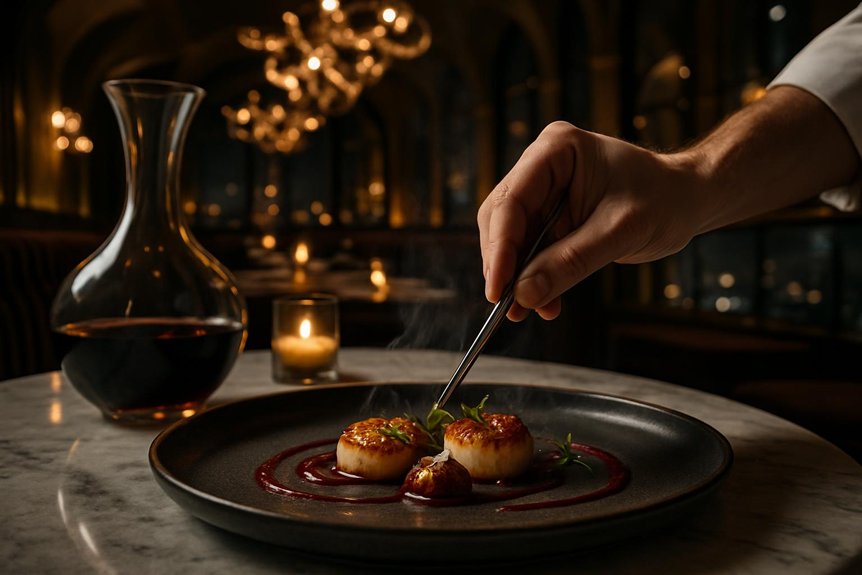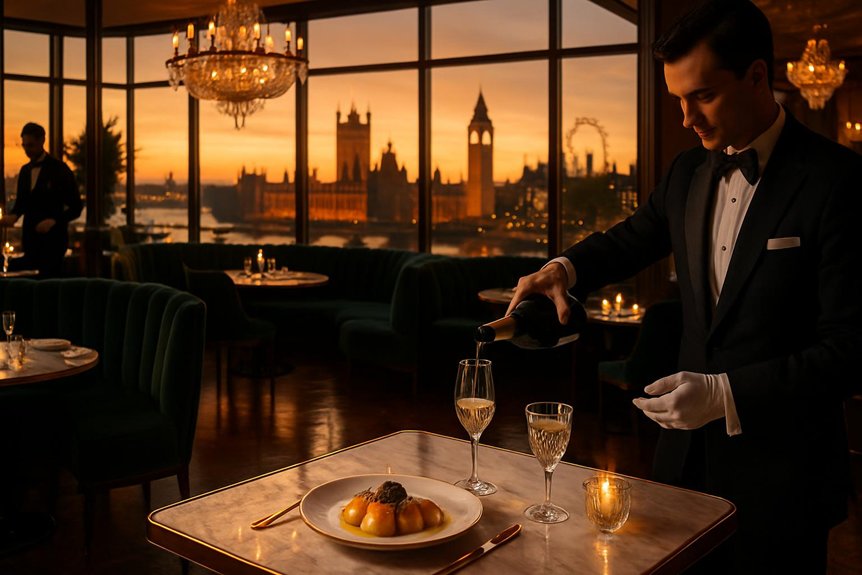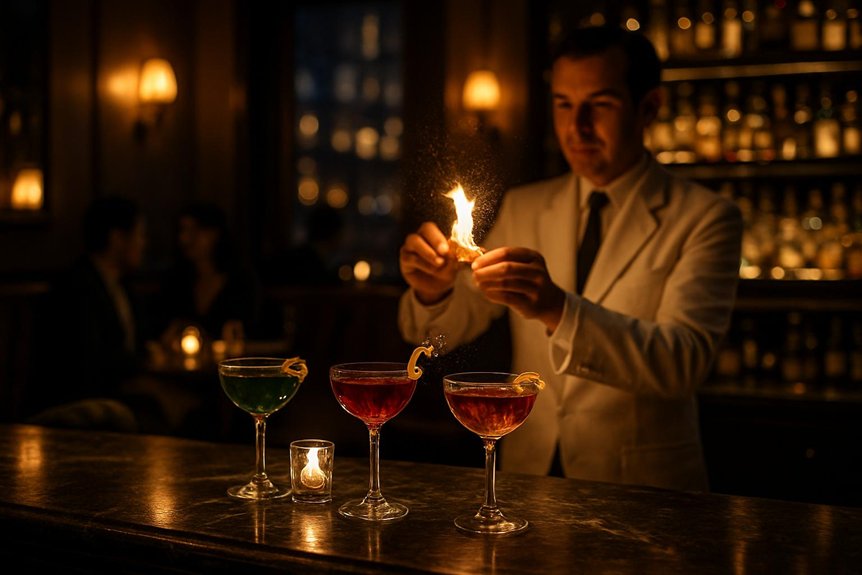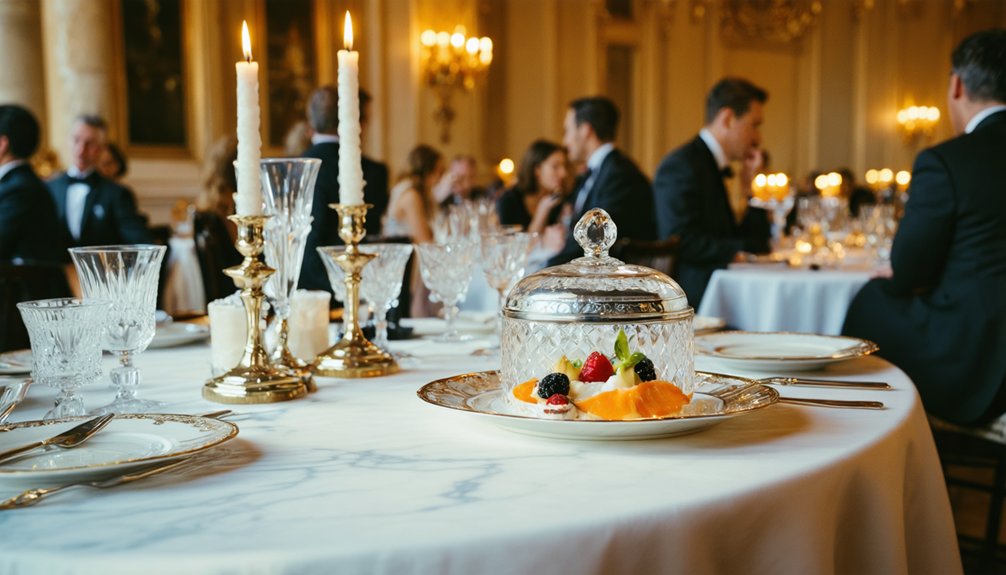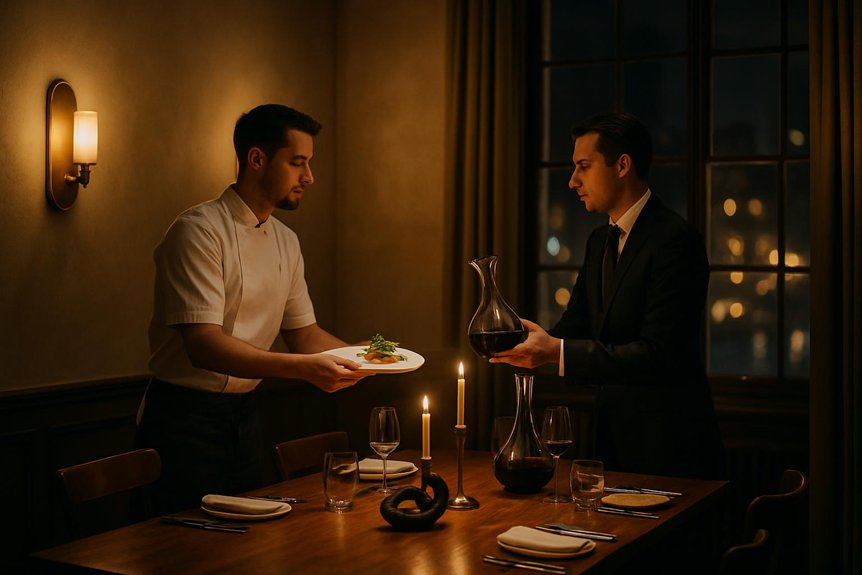In London’s luxury dining rooms, cuisine operates like a curated exhibition. Chefs compose plates with the precision of painters, aligning color, texture, and temperature to guide perception. Spaces are staged with lighting, acoustics, and materials that frame each course as an installation. Techniques draw on science, but the intent is narrative control. Sustainability shapes the palette. The result is a measured performance where taste becomes interpretation—and the next course changes the story.
Michelin Stars as Modern Masterpieces
Three gleaming stars can function like brushstrokes on a canvas, signaling a chef’s command of technique, vision, and consistency. In London’s luxury dining scene, the accolade frames each plate as a disciplined statement, where Artistic innovation is measured against rigor rather than whim.
Critics observe how tasting menus establish rhythm, color, and contrast, translating terroir into precise culinary expression. Sauces act as shading, textures provide depth, and temperature becomes a controlled light source.
The star system, while codified, rewards risk that refines tradition instead of discarding it. Diners encounter compositions that reveal intent course by course, each detail calibrated to sustain narrative momentum. Here, mastery is not spectacle; it is authorship, edited relentlessly until flavor, form, and meaning align.
For those seeking a unique nightlife experience, A Night in the Living Room at Meraki Restaurant offers an evening of dining, dancing, and great vibes.
Dining Rooms Curated Like Galleries
Often the dining room reads like a white-cube gallery: neutral walls, controlled sightlines, and calibrated lighting frame the plate as the central exhibit. In London’s luxury restaurants, furniture acts like plinths, linens like canvases, and silence like an acoustic buffer, allowing visual focus to settle on composition and color.
Artworks are selected with curatorial intent, not decoration; the room becomes a Curated exhibition that shifts with seasons and menus.
Technology supports Interactive art elements without disturbing serenity, inviting contemplation rather than spectacle.
- Spatial choreography: corridors open to vistas, tables staged to create depth, and reflective surfaces extend perspective.
- Material dialogue: stone, lacquer, and matte ceramics temper glare and heighten chroma.
- Temporal pacing: service cadence aligns with lighting fades, echoing gallery sequencing.
Meraki in London exemplifies this concept, with elegant furnishings and classic architectural features that create an inviting atmosphere, complementing the curated blend of artistic influences.
Chefs as Storytellers and Designers
How does a chef translate narrative into form? In London’s luxury scene, the answer is spatial, tactile, and visual. Chefs sketch plates like stage sets, balancing color, height, and negative space to imply character and conflict. They choreograph service to cue focus, letting aroma precede sight, and texture follow heat, so meaning unfolds through sensation rather than speech.
Materials drive metaphor: smoke domes suggest ephemerality, reflective glazes imply duality, fermented notes reference time. Interactive installations bridge kitchen and gallery, inviting guests to crack sugar “canvases” or paint sauces, turning diners into co-authors. Edible art becomes a medium of symbols—botanical imprints, architectural molds, geological layers—each element chosen for narrative resonance. The chef operates as designer, editor, and curator, crafting coherence from discipline and restraint. At Meraki in London, chefs and mixologists collaborate to create dishes and cocktails that emphasize flavor harmony, ensuring a seamless dining experience.
Tasting Menus as Narrative Journeys
Tasting menus are structured as narratives, where course progression shapes a clear arc from overture to resolution.
Each plate advances the storyline through calibrated shifts in texture, temperature, and intensity.
Sensory pairing choreography aligns flavor, aroma, and visual cues to control pace and emotional cadence.
Course Progression Storytelling
Why do some meals feel like chapters turning rather than plates arriving? In London’s luxury dining rooms, course progression becomes a narrative device, guiding the guest from prologue to denouement. Chefs arrange flavors, temperatures, and textures with the logic of scenes, invoking Abstract sculpture in plated forms and signaling Culinary innovation through unexpected sequencing. The story advances without speech: restraint, escalation, resolution.
1) Structure: A bright, concise opener establishes pace; mid-courses deepen tension with layered umami; a contemplative interlude resets focus; a final savory crest leads into reflective sweetness.
2) Motif: Recurrent ingredients appear in altered roles, creating continuity while avoiding repetition.
3) Pacing: Portions calibrate attention; briefer courses quicken momentum, extended courses invite stillness, ensuring a coherent arc that rewards sustained curiosity.
Sensory Pairing Choreography
Where does meaning emerge when senses are braided rather than stacked? In London’s luxury dining rooms, chefs and sommeliers design tasting menus as narrative corridors, using sensory orchestration to cue memory, tension, and release. Flavor choreography governs sequence and tempo: salinity opens, acidity propels, umami anchors, sweetness resolves. Pairings are cast as motifs—herbal steam preceding a bitter leaf, a mineral wine echoing oyster brine, a cedar note bridging land to sea.
The choreography includes texture and temperature as plot devices. A chilled gel yields to a crackling tuile; warmth lifts aroma for the denouement. Lighting and sound calibrate perception, tightening focus before a pivotal course. Precision avoids overload; restraint preserves contour. The result is a coherent arc where each pairing advances story, not spectacle.
British Terroir Meets Global Influence
British kitchens now frame seasonal bounty—coastline shellfish, heritage grains, hedgerow fruits—through a lens of global techniques.
Local produce anchors flavor while methods from Japan, Mexico, and the Nordics refine texture, preservation, and heat. The result is terroir-driven tasting menus that read British in provenance yet cosmopolitan in craft.
Seasonal British Bounty
In early autumn markets, crates of Sussex apples, Norfolk samphire, and Orkney scallops reveal a terroir defined by wind, salt, and rain. London’s luxury dining rooms translate this landscape through disciplined seasonality: tart apple lacquer glazes day-boat scallops; samphire’s brine sharpens creamy barley; upland venison meets hedgerow berries.
The Farm to Table ethic becomes choreography—producers, chefs, and sommeliers aligning ripeness with service tempo and cellar arcs. Wine Pairing follows the produce: textured English Chardonnay for scallops, mature Bordeaux for venison, pet-nat for orchard desserts.
1) Ingredient chronology: menus pivot weekly, tracking estuary tides and upland culls.
2) Texture dialectics: crisp, saline, and gamey balanced by ferment, smoke, and dairy.
3) Provenance clarity: supply notes list boat names, orchards, and curing dates, anchoring luxury in place.
Global Techniques, Local Produce
Though rooted in chalk, heather, and tide, the larder broadens under global hands: koji softens Belted Galloway brisket; yuzu lifts Kentish crab; gochujang brushes Suffolk pork; vadouvan perfumes Isle of Wight tomatoes.
Across London’s luxury dining rooms, British terroir becomes a canvas for Artistic fusion, where culinary craftsmanship reframes familiar ingredients without obscuring origin. Ferments, misos, and garums temper native sweetness; binchotan and tandoor impart focused heat to day-boat catch; sashimi knife-work finds new purpose in chalkstream trout.
Precision sauces—brown butter ponzu, smoked dashi jus, green peppercorn caramel—translate hedgerow and shoreline into global dialects. Vegetables hold equal voice: Norfolk carrots glazed in black lime, Yorkshire beets lacquered with tamarind and molasses. Technique migrates; provenance anchors. The dialogue is fluent, restrained, exacting.
Terroir-Driven Tasting Menus
From individual techniques applied to local harvests, the conversation gathers into courses that chart place through cadence and contrast. London’s luxury dining rooms now treat British terroir as a palette: chalkland vegetables, Kentish orchard sweetness, Hebridean salinity. Chefs compose sequences where ingredient sourcing determines tempo, while global methods sharpen articulation—koji-cured trout beside nettle velouté; miso-glazed celeriac offset by sea buckthorn.
Precision in wine pairing links soils to glasses, moving from English blanc de blancs to Jura oxidative tones, then island malts in aromatized reductions.
1) Provenance as structure: estates and day-boat logs define course order.
2) Technique as translation: fermentation, smoking, and aging frame micro-seasonal shifts.
3) Dialogue in the glass: wine pairing mirrors texture—acid for fat, salinity for sweetness, minerality for earth.
Tableware, Textures, and the Art of Plating
A plate is more than a surface; it frames flavor, guides the eye, and sets the tone before a bite is taken. In London’s luxury dining rooms, chefs and designers collaborate so form amplifies taste. Pieces born of ceramic craftsmanship provide weight, warmth, and subtle glaze variations that echo seasonal produce.
Plating reads like composition: negative space, height, and rhythm build narrative. Texture contrast is engineered—crisp shards against silk purées, chilled gels beside warm roasts—so the mouth registers sequence and surprise.
Metal, stone, and porcelain are chosen for conduction and color neutrality, letting pigments of beet, saffron, or sea herbs remain vivid. Edges matter; a beveled rim contains sauces, while matte finishes soften glare. Every vessel becomes a quiet stage for intention.
Immersive Technology and Multisensory Dining
Lights dim, soundscapes swell, and hidden projectors turn dining rooms into responsive theaters where cuisine leads the script. In London’s luxury spaces, immersive technology choreographs pace, temperature, aroma, and light to synchronize with each course. Plates cue ambient shifts; a citrus note brightens under a sunrise hue, while brass tones underscore roasted depth.
Rather than spectacle for its own sake, the goal is calibrated perception—taste sharpened by context, memory activated by multisensory prompts, and narrative delivered through timing.
- Virtual reality tastings pair micro-courses with panoramic terroir vistas, aligning flavor with origin.
- Augmented dining overlays data—provenance, sustainability metrics, and pairing logic—directly onto the table.
- Haptic tableware and directional audio isolate textures and timbres, allowing diners to parse crunch, silk, smoke, and echo with forensic focus.
Collaborations With Contemporary Artists
Chef-artist menu collaborations shape courses like curated exhibitions, aligning flavors with specific visual concepts.
Dining rooms function as galleries, where rotating installations contextualize the meal and guide the guest’s sensory focus.
Limited-edition tableware commissions extend the collaboration to the plate, turning serving vessels into collectible works that influence presentation and pacing.
Chef-Artist Menu Collaborations
Two creative disciplines converge when chefs invite contemporary artists to co-author menus, treating the plate as a curated canvas. In London’s luxury scene, these partnerships translate visual vocabularies into flavor, often merging farm to table sourcing with avant garde technique.
The process reshapes courses as temporal installations, where seasonality, pigment, and texture become shared grammar.
1) Concept development: artists propose narrative frameworks—color fields, kinetic motifs, or material studies—while chefs map these into courses, aligning produce availability with thematic arcs.
2) Technique translation: culinary methods echo studio practices—smoking as chiaroscuro, aeration as negative space, glazing as varnish—integrating edible mediums with disciplined restraint.
3) Sensory scoring: pacing, temperature, and contrast are choreographed, ensuring ideas read clearly on the palate, from vegetal minimalism to opulent finales, without overwhelming coherence.
Dining Rooms as Galleries
One dining room at a time, London’s high-end restaurants recast themselves as galleries, commissioning contemporary artists to shape spatial atmospheres as deliberately as the kitchen composes plates. Paintings, light sculptures, and site-specific installations frame the meal, guiding sightlines and pacing, so that food presentation reads against curated backdrops and tonal palettes.
This choreography turns décor into discourse, where color, texture, and shadow function as prelude and counterpoint. Collaborations extend to immersive lighting schemes and kinetic works that modulate mood between courses, aligning with a notion of culinary architecture: the room acts as a built narrative that diners traverse.
Curators consult with chefs to synchronize visual intensity with flavor arcs, ensuring artworks heighten anticipation, temper richness, and underscore seasonality without overwhelming the plate.
Limited-Edition Tableware Commissions
A growing number of restaurants commission limited-edition tableware from contemporary artists, treating plates, bowls, and glassware as sites of authorship rather than neutral vessels. In London’s luxury scene, bespoke settings extend storytelling beyond the cuisine, aligning plating with ceramic artistry and artisan craftsmanship.
These collaborations recalibrate the dining ritual, where surface, form, and glaze direct how guests perceive temperature, texture, and aroma.
1) Provenance: Editions are often numbered, signed, and accompanied by certificates, shifting tableware into collectible design that documents creative labor and technique.
2) Functionality: Chefs and artists iterate prototypes to balance durability, stackability, and heat retention with sculptural intent, ensuring service viability.
3) Ephemerality: Seasonal menus pair with short-run commissions, allowing restaurants to cycle visual languages, spotlight emerging artists, and maintain rarity without diluting identity.
Sustainability as a Design Philosophy
How might sustainability shift from a constraint to a creative engine when art meets cuisine? In London’s luxury dining rooms, sustainability operates as a brief, not a burden. Chefs and designers pursue eco conscious sourcing as a curatorial act, selecting biodiverse ingredients and heritage grains that shape color, texture, and narrative.
Materials follow the same logic: reclaimed timbers, low-impact ceramics, and linens dyed with plant pigments create a quiet, tactile stage.
Energy footprints guide choreography—induction, batch cooking, and waste-heat capture redefine back-of-house craft.
Guests encounter renewable packaging as part of the aesthetic: compostable menus, reusable vessels, and elegantly modular boxes for leftover courses.
Upcycled glassware, candle refills, and closed-loop floristry turn operational choices into visible art, aligning culinary luxury with measurable environmental intelligence.
The Future of Luxe Culinary Performance
Tomorrow’s luxe culinary performance pivots from spectacle to systems, where precision tech, sensory dramaturgy, and ethics converge into seamless ritual. In London’s top rooms, chefs function as conductors, coordinating robotics, smart ovens, and AI timing with human touch.
Fusion innovation becomes method, not novelty: terroir-specific pairings meet micro-seasonal sourcing, while artistic presentation evolves into choreography that directs gaze, scent, and sound.
1) Data-guided craft: kitchens map flavor volatility, fermentation curves, and heat diffusion, enabling consistent nuance and adaptive plating in real time.
2) Immersive staging: projection, scent dispersion, and acoustic design create spatial narratives that heighten memory without eclipsing taste.
3) Responsible opulence: closed-loop systems, low-impact proteins, and transparent provenance align luxury with accountability.
The result is calibrated emotion—measured, luminous, and quietly radical.
Conclusion
In London’s luxury dining rooms, art and cuisine converge into a singular, eloquent language. Chefs compose narratives with precision; spaces frame them like living galleries. Tasting menus travel from British terroir to global inflections, amplified by technology, collaborations, and sustainable intent. The experience feels both intimate and theatrical—taste as texture, scent as color, memory as canvas. If perfection could be plated a thousand times over, it would be here, where craft and imagination set the table for the future.
